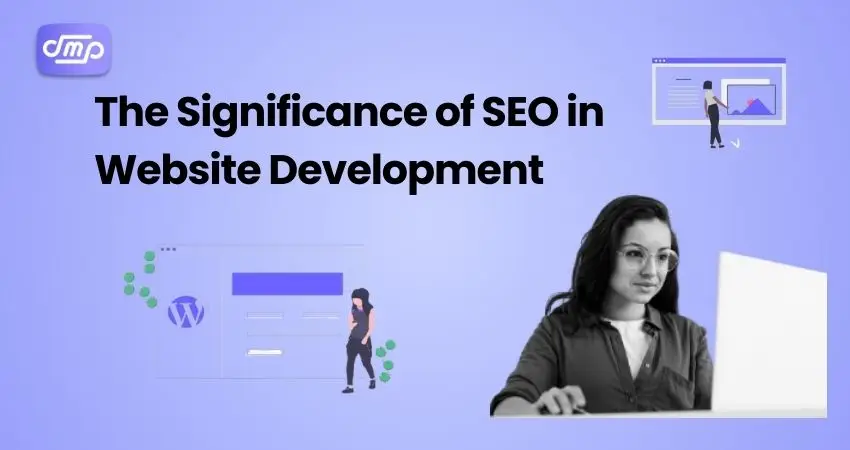
Table of Contents
Since SEO (Search Engine Optimisation) immediately affects a website’s visibility and rating on search engine results pages (SERPs), it is essential to the development of websites. The following best practices emphasise the significance of SEO in website development.
- Keyword research: Keyword research helps you to find relevant terms and phrases that your target market is probably using to look for goods, services, or website-related information by conducting keyword research and optimisation. Make strategic use of these keywords in the headings, titles, meta descriptions, and URLs of your website.
- Quality content: SEO will encourage you to produce valuable, interesting, and high-quality material that meets the demands and preferences of your target audience. Keep readers interested by adding new content to your website on a regular basis. This will also encourage search engines to crawl and index your site more often.
- Improved Navigation and Structure of Websites: SEO in website development helps you to make sure that both users and search engine crawlers can easily explore your website by creating a user-friendly structure and clear navigation. Create logical divisions and subcategories for your content, and provide internal links with meaningful anchor language.
- Mobile Optimisation: SEO in website development helps you to make sure your website is responsive and mobile-friendly given the rise in the use of mobile devices. Mobile optimisation can greatly enhance your search engine optimisation (SEO) results, as Google and other search engines give preference to mobile-friendly websites in their ranks.
- Improve user experience: SEO improves user experience by making your website load faster. This is known as page speed optimisation. It will help you find and address problems that can slow down your websites, such as big-picture files, an excessive number of plugins, or inefficient coding.
- Meta Tags and Descriptions: To increase click-through rates and visibility in search results, SEO in website development crafts catchy meta titles and descriptions for each page that include pertinent keywords. For every page on your website, you need to make sure the meta tags are clear, specific, and concise.
- Image optimisation: The SEO assists in making use of alt tags, descriptions with pertinent keywords, and descriptive file names to enhance your photographs. It reduces the size of your files without compromising quality by compressing your photos, which will speed up page loads and enhance user experience.
- Schema markup: SEO in website development makes use of schema markup to give search engines more information about your content, including reviews, ratings, events, and merchandise. Rich snippets and other enhanced search results can be displayed by search engines with more understanding of your website’s content thanks to schema markup.
- Backlinks: To increase your website’s authority and credibility in the eyes of search engines, you need to obtain high-quality backlinks from respectable and pertinent websites in your sector. You need to put your attention on organic link-building techniques like writing insightful content, writing guest posts, and interacting with influencers.
- Frequent Monitoring and Analysis: SEO analysis involves making use of resources like Google Analytics and Google Search Console to keep an eye on the functionality of your website. It examines important indicators like traffic, rankings, click-through rates, and conversion rates to pinpoint areas that need work and adjust your SEO approach appropriately.
SEO in website development may improve search engine rankings, increase organic traffic to your website, and improve website visibility by putting these best practices into effect.
The Significance of SEO in Website Development

Website creation is impacted by SEO in a number of important ways:
- Planning and Creation of Content: SEO factors play a role in the planning and development of content for websites. In order to create content that is both relevant and valuable, keyword research is helpful in identifying the themes and phrases that users are searching for. Optimising content with relevant headings, keywords, and structure is necessary to increase its exposure in search results.
- Website Structure and Navigation: The design of a website’s structure and navigation is guided by SEO best practices. Content may be found and understood more readily by users and search engine crawlers when a website has a well-organized structure and intuitive navigation. This involves making sure that content is accessible on all devices, optimising internal linking, and building logical hierarchies.
- Technical Optimisation: To guarantee peak performance, SEO demands careful consideration of the technical facets of website creation. elements like page speed and mobile Search engine rankings are influenced by elements like crawlability, indexability, mobile responsiveness, and page speed. To improve SEO, developers must put strategies like code optimisation, faster server response times, and addressing crawl issues into practice.
- Meta Tags and Descriptions: Each page’s meta tags and descriptions are created with SEO in mind. These components offer succinct descriptions of the page content that show up in search engine rankings. Enhancing meta tags with pertinent keywords and captivating descriptions can help websites increase organic traffic and click-through rates.
- Optimisation of photos and Multimedia: SEO factors also apply to the optimisation of photos and multimedia. Search engines can better comprehend and index visual material when descriptive filenames, alt tags, and captions are used. Multimedia components that are optimised improve user experience and boost overall SEO performance.
- Creating Links and Link Building and Authority: Using high-quality backlinks, SEO entails establishing credibility and authority. Developers might use techniques to obtain inbound links from reliable directories and websites. Furthermore, internal linking improves SEO performance by building relationships between pages and distributing link equity throughout the website.
- Monitoring and Optimisation: Throughout the website construction process, SEO in website development calls for constant monitoring and optimisation. Analytics tools are used by developers to monitor important metrics such as traffic, conversions, and rankings. They may make wise selections to hone SEO tactics and enhance website performance over time by evaluating data and seeing patterns.
SEO-friendly web design

It is imperative to have an SEO-friendly web design for multiple reasons:
- Increased Search Engine Visibility: A website designed using SEO best practices makes it easier for search engines to index and crawl the content on your site. By doing this, you raise the likelihood that your website will appear higher in search engine results pages (SERPs) for pertinent keywords and phrases, drawing in more potential customers.
- Enhanced Natural Traffic: A website that is more visible in search results receives an increase in natural traffic. Optimised content, URLs, and site structure are examples of SEO-friendly design components that help draw in targeted customers who are actively looking for products, services, or information about your company.
- Enhanced User Experience: There is often overlap between SEO-friendly design concepts and user experience enhancement principles. A cleanly organised website with quick loading times, easy navigation, and mobile friendliness offers a well-designed website that loads quickly, has easy navigation, and is responsive to mobile devices offers a satisfying user experience that increases engagement and decreases bounce rates.
- Increased Conversion Rates: Users who find a website easy to use and intuitive are more likely to explore additional pages and complete desired actions, such as purchasing something, subscribing to a newsletter, or completing a contact form. You may increase conversion rates and accomplish your business objectives by optimising your website for both visitors and search engines.
- Competitive Advantage: Higher search engine ranking websites are more likely to draw in organic visitors, produce leads, or close sales, providing you a competitive edge in higher search engine ranking websites are more likely to draw in organic visitors, produce leads, or close sales, and offering you a competitive advantage in your sector.
- Cost-Effectiveness: While paid advertising might increase website traffic right away, SEO-friendly web design has longer-term advantages at a cheaper price. After optimisation, you won’t need to pay for continuous advertising because your website will continue to bring in organic traffic and lead generation.
- Adaptability to Algorithm Changes: Since search engine algorithms are always changing, an SEO strategy that works today might not work as well tomorrow. On the other hand, websites with SEO-friendly designs are more able to adjust to changes in search engine algorithms and hold onto their ranks over time.
- Enhanced Brand Credibility: Users frequently view websites with better search engine rankings as more reliable and trustworthy. By making your website more search engine friendly, you may establish your brand’s authority and credibility in your sector, which will win over more of your target audience’s trust and loyalty.
Conclusion
SEO in website development is included in many phases of the creation of websites, impacting user experience, technological implementation, content strategy, and continuous optimisation. Developers may design visually appealing and user-friendly websites that are also optimised for search engine visibility and performance by giving priority to SEO best practices.
Investing in an SEO-friendly website design is crucial to raising search engine rankings, drawing in organic traffic, increasing user experience, and succeeding in the long run on the internet. Your company can be positioned for growth and a competitive edge in the online market by implementing SEO best practices into the website creation process.











